Related Research Articles
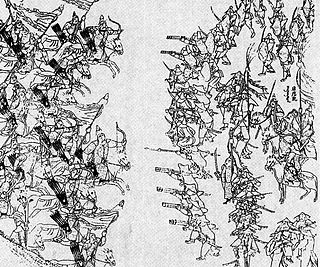
The Battle of Sarhū refers to a series of battles between the Later Jin dynasty and the Ming dynasty and their Joseon allies in 1619. The battle is notable for the heavy use of cavalry by the Later Jin in defeating Ming and Joseon forces equipped with hand cannons, cannons, and matchlocks.

The Later Jin invasion of Joseon occurred in early 1627 when the Later Jin prince Amin led an invasion of the Joseon dynasty. The war ended after three months with the Later Jin establishing itself as sovereign tributary overlord over Joseon. However Joseon continued its relationship with the Ming dynasty and showed defiance in solidifying its tributary relationship with the Later Jin. It was followed by the Qing invasion of Joseon in 1636.
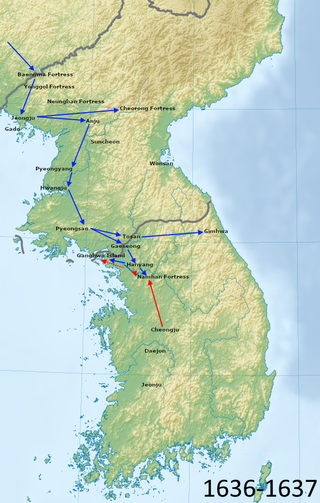
The Qing invasion of Joseon occurred in the winter of 1636 when the newly established Qing dynasty invaded the Joseon dynasty, establishing the former's status as the hegemon in the Imperial Chinese Tributary System and formally severing Joseon's relationship with the Ming dynasty. The invasion was preceded by the Later Jin invasion of Joseon in 1627.
The Seven Grievances was a manifesto announced by Nurhaci, khan of the Later Jin, on the thirteenth day of the fourth lunar month in the third year of the Tianming era of his reign; 7 May 1618. It effectively declared war against the Ming dynasty.
The Jianzhou Jurchens were one of the three major groups of Jurchens as identified by the Ming dynasty. Although the geographic location of the Jianzhou Jurchens changed throughout history, during the 14th century they were located south of the Wild Jurchens and the Haixi Jurchens, and inhabited modern-day Liaoning and Jilin provinces in China. The Jianzhou Jurchens were known to possess an abundant supply of natural resources. They also possessed industrial secrets, particularly in processing ginseng and the dyeing of cloth. They were powerful due to their proximity to Ming trading towns such as Fushun, Kaiyuan, and Tieling in Liaodong, and to Manpojin camp near Korea.
Li Chengliang or Lee Seong-ryang, courtesy name Ruqi (汝契), art name Yincheng (引城), was a Ming dynasty general.
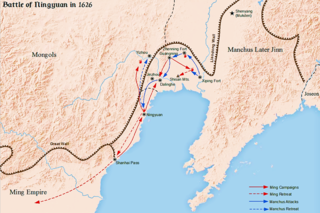
The Battle of Ningyuan took place between the Ming dynasty and the Later Jin dynasty in 1626. The Later Jin had been waging war on the Ming for several years, and their leader Nurhaci had deemed Ningyuan to be a suitable target for his attack, in part due to advice from a Ming defector, Li Yongfang. Later Jin failed to take the city and Nurhaci was wounded in the assault, dying eight months later. The Ming emerged victorious, marking a temporary resurgence of the Ming army after an eight-year-long series of defeats.

Nurhaci, also known by his temple name as the Emperor Taizu of Qing, was the founding khan of the Jurchen-led Later Jin dynasty.
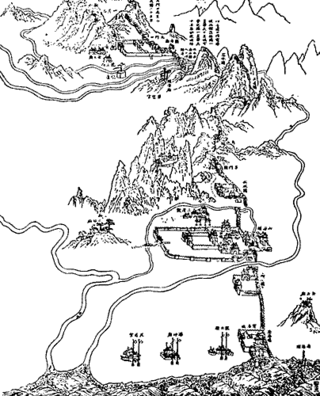
The transition from Ming to Qing or the Manchu conquest of China from 1618 to 1683 saw the transition between two major dynasties in Chinese history. It was a decades-long conflict between the emerging Qing dynasty, the incumbent Ming dynasty, and several smaller factions. It ended with the consolidation of Qing rule, and the fall of the Ming and several other factions.
The Battle of Dalinghe was a battle between the Later Jin dynasty and the Ming dynasty that took place between September and November 1631. Later Jin forces besieged and captured the fortified northern Ming city of Dalinghe in Liaoning. Using a combined force of Jurchen and Mongol cavalry, along with recently captured Ming artillery units, the Later Jin khan Hong Taiji surrounded Dalinghe and defeated a series of Ming reinforcement forces in the field. The Ming defenders under general Zu Dashou surrendered the city after taking heavy losses and running out of food. Several of the Ming officers captured in the battle would go on to play important roles in the ongoing transition from Ming to Qing. The battle was the first major test for the Chinese firearms specialists incorporated into the Later Jin military. Whereas the Later Jin had previously relied primarily on their own Eight Banners cavalry in military campaigns, after the siege of Dalinghe the Chinese infantry would play a larger role in the fighting. Unlike Nurhaci's failed siege at the Battle of Ningyuan several years prior, the siege of Dalinghe was a success that would soon be replicated in Songshan and Jinzhou, paving the way for the establishment of the Qing dynasty and the ultimate defeat of the Ming.

The Later Jin, officially known as Jin or the Great Jin, was a Jurchen-led royal dynasty of China and a khanate ruled by the House of Aisin-Gioro in Manchuria, as the precursor to the Qing dynasty. Established in 1616 by the Jianzhou Jurchen chieftain Nurhaci upon his reunification of the Jurchen tribes, its name was derived from the earlier Jin dynasty founded by the Wanyan clan which had ruled northern China in the 12th and 13th centuries.

The Battle of Fushun was the first military conflict in the war between the Jurchen-led Later Jin and the Ming dynasty. The battle ended in a decisive victory for the Later Jin and resulted in the capture of Fushun and two other nearby fortresses.
The Battle of Tieling was a military conflict between the Later Jin and Ming dynasty. In the summer of 1619 Nurhaci invaded the town of Tieling, the ancestral home of the Li clan. Ming had fortified the town with cannons, but many of their soldiers defected to the Jin, and they were unable to reload their cannons before the walls were taken. Li Ruzhen, one of the last scions of the Tieling Li, fled the battle.

The Battle of Shen-Liao was a military conflict between the Later Jin and the Ming dynasty. In early 1621 Nurhaci, khan of the Later Jin, invaded Liaodong and captured the cities of Shenyang and Liaoyang from the Ming.

The Battle of Guanging was a military conflict between the Later Jin dynasty and the Ming dynasty in 1622. It occurred around the Ming's northern city of Guangning, which fell to the Later Jin in 1622.

The Battle of Ning-Jin was a military conflict between the Later Jin dynasty and the Ming dynasty. In the spring of 1627, the Later Jin khan Hong Taiji invaded Ming territory in Liaoning under the pretext of illegal construction on Later Jin territory.
The Jisi Incident was a military conflict between the Later Jin dynasty and the Ming dynasty, named because it happened in 1629, a jisi year according to the Chinese sexagenary cycle. In the winter of 1629 Hong Taiji bypassed Ming's northeastern defenses by breaching the Great Wall of China west of the Shanhai Pass and reached the outskirts of Beijing before being repelled by reinforcements from Shanhai Pass. The Later Jin secured large amounts of war material by looting the region around Beijing. This was the first time Later Jin forces had broken through the Great Wall since they rose up against the Ming dynasty.
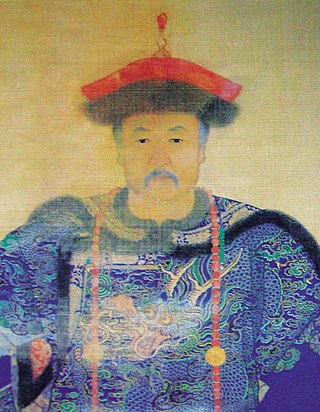
Fan Wencheng was a Qing dynasty scholar-official, prime minister and grand secretary. His official career went through four generation of Qing dynasty emperors through Nurhaci, Hong Taiji, Shunzhi, and Kangxi. Many rules and regulations in the early days of the Qing dynasty were drafted by him.
Li Yongfang was a Chinese general of the Ming dynasty and Qing dynasty known for defecting to the Qing dynasty, due to the Ming dynasty losing the city of Fushun in Liaoning to the Qing. Li Yongfang along with many other Han Chinese defected to the Qing as the old Ming system was declining and corrupt, and the Qing provided an opportunity for the Han Chinese to continue their culture. One of Li Yongfang's descendants Li Shiyao was sentenced to death by the Qianlong emperor but was spared his life when he helped suppress the Lin Shuangwen rebellion in Taiwan.

The Jurchen unification were a series of events in the late 16th and early 17th centuries that led to the unification of the Jurchen tribes under the Jianzhou Jurchen leader Nurhaci. While Nurhaci was originally a vassal of the Ming dynasty who considered himself a local representative of imperial Ming power, he also had a somewhat antagonistic relationship with the Ming due to Ming's involvement in events early on in his life that led to the death of his father and grandfather combined with his own increasing ambition.